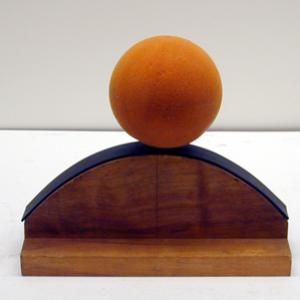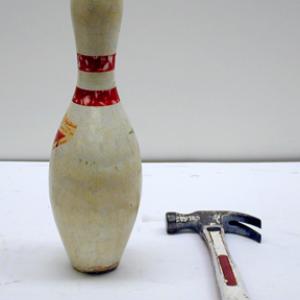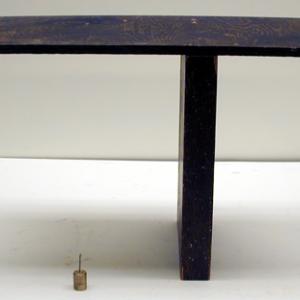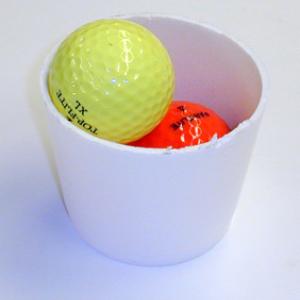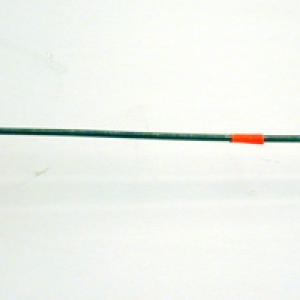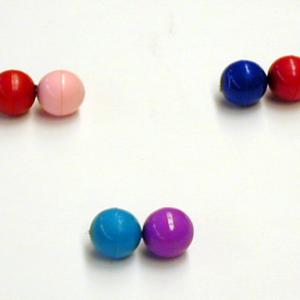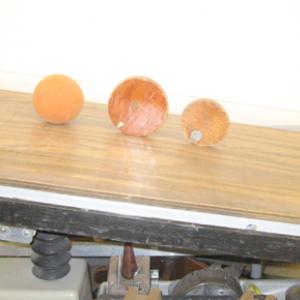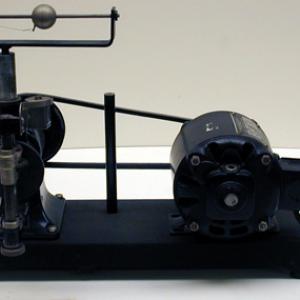College of Liberal Arts & Sciences
1J10.09 - Center of Mass Demo
Balance the ball on the negatively curved surface. The foam ball has an offset center of mass which can be balanced on the curve when that mass is toward the bottom of the ball. The Guac ball is a blow up version of the foam ball and a round version of the larger Bozo demo.
The bowling pin or the hammer can be thrown in the air in a rotational motion and you should be able to see the spot in which they rotate. This also holds true for the binary system.
The milk stool is just barely balanced and will tip with an addition to just a small weight on the long end.
Place the two golf balls in the Styrofoam cup so that one golf ball is setting higher than the other, but is off center. Hold the cup at a height of 4 feet and drop. The cup should tilt so that the golf balls would hit the ground simultaneously if they weren't enclosed by the cup.
Roll the magnetic marbles together at a tangential angle. They should rotate at the center of mass.
The ball and the disks with the off-center centers of mass can be shown dramatically by placing them on the incline and watching them roll up hill a short way.
Note: This small binary apparatus is kept in the 1J10.09 "Center of Mass Demos" box. The small binary apparatus is designed to be used with the Cenco Rotator Unit. Secure the apparatus in the chuck of the unit and slowly increase the rotation rate until a center of mass of the system is observed.
- C. H. Worner, "Certain Tricks to Calculate Some Centers of Mass", TPT, Vol. 61, #2, Feb. 2023, p. 110.
- "Figuring Physics", TPT, Vol. 51, # 8, Nov. 2013, p. 452.
- Albert A. Bartlett, "The Physics of a Simple Camera Stabilizer", TPT, Vol. 50, # 5, May 2012, p. 268.
- Bruce Denardo, Richard Raspet, "Hanging-Picture Instability", TPT, Vol. 43, # 3, May 2005, p. 298 - 301.
- E. Roger Cowley, Brian Holton, George K. Horton, "Blocks and Bullets Demo", TPT, Vol. 36, # 4, p. 198-199, April 1998.
- E. Roger Cowley, Brian Holton, George K. Horton, "A Thought Provoking Demonstration", TPT, Vol. 36, p. 24, Jan 1998.
- "Figuring Physics", TPT, Vol. 36, # 8, p. 486, Nov. 1998.
- Benjamin S. Perkalskis and J. Reuben Freeman, "Only an External Force Shifts the Center-of-Mass", TPT, Vol. 35, # 6, Sept. 1997, p. 368.
- Sean M. Cordry, "Stability and That Pesky Center-of-Mass", TPT, Vol. 35, # 5, p. 300, May 1997.
- James S. Walker, "Raising or Lowering a Rope: Thereby Hangs a Tale", TPT, Vol. 33, # 6, Sept. 1995, p. 389.
- Marie Baehr, "Center of Mass of a Can With A Varying Level of Liquid", TPT, Vol. 30, # 1, Jan. 1992, p. 34.
- Manfred Bucher, Shengbo Zhu, and Randy Dotta-Dovidio, "Center-of-Mass Baton", TPT, Vol. 29, # 2, p. 74, Feb. 1991.
- Allan Walstad, "The Hammer Flip", TPT, Vol. 28, # 8, Nov. 1990, p. 556.
- Mario Iona, "Would You Believe?", TPT, Vol. 26, # 6, p. 406, Sept. 1988.
- R.D. Edge, "Rotational Inertia", TPT, Vol. 26, # 6, p. 405, Sept. 1988.
- "Figuring Physics", TPT, Vol. 25, # 2, Feb. 1987, p. 110.
- Ernie McFarland, "Center of Mass Revisited", TPT, Vol. 21, # 1, Jan. 1983, p. 42.
- John B. Hart, "Great Ellipsoids of Inertia and Space Physics", TPT, Vol. 6, # 3, March 1968, p. 118.
- Robert Liefeld, Aaron Berger, "The Dipole - Dipole Interaction At A Glance", AJP, Vol. 73, # 1, p. 93, Jan. 2005.
- Thomas B. Greenslade, Jr., "Center of Mass Demonstration (Photo)", AJP, Vol. 72, # 1, Jan. 2004, p. 125.
- M- 662: "Baton-Elliptical Bulls-Eye", DICK and RAE Physics Demo Notebook.
- M- 35, 36: Richard Manliffe Sutton, Demonstration Experiments in Physics.
- R. D. Edge, "Center of Mass", A Potpourri of Physics Teaching Ideas - Mechanics, p. 103.
- George M. Hopkins', "A Novel Top", Experimental Science, Volume Two, p. 198.
- Carson I. A. Ritchie, "Balancer", Making Scientific Toys, p. 92.
- Jodi and Roy McCullough, "Center of Gravity and Torque with a Bop Bag", The Role of Toys in Teaching Physics, p. 4.112.
- Jodi and Roy McCullough, "Center of Gravity with a Guac Ball", The Role of Toys in Teaching Physics", p. 4.118.
- David Kutliroff, "58, An Argument for a Heliocentric Planetary System", 101 Classroom Demonstrations and Experiments For Teaching Physics, p. 129.
- Borislaw Bilash II, David Maiullo, "Throwing Off Your Center of Mass", A Demo a Day: A Year of Physics Demonstrations, p. 159.
- "Feat of Balancing on Chairs", The Boy Scientist, p. 220.
- "Center of Gravity Experiment", The Boy Scientist, p. 221.
- Jearl Walker, "1.117, Carrying Loads on the Head", The Flying Circus of Physics Ed. 2, p. 57.
- Jearl Walker, "1.149, Stability of a Pop Can", The Flying Circus of Physics Ed. 2, p. 71.
- Raymond Bruman, "Balancing Stick", Exploratorium Cookbook I, 75-1 - 75-2.
- Robert Ehrlich, "Colliding Magnetic Marbles", Why Toast Lands Jelly-Side Down, p. 66.
- Bobby Mercer, "Wobble Ball", Junk Drawer Physics, p. 51.
- Tik L. Liem, "Stand A Dollar Bill On Your Fingers", Invitations to Science Inquiry - Supplement to 1st and 2nd Ed. p. 105.
- Julius Sumner Miller, Q223 & A223, Millergrams II – Some More Enchanting Questions for Enquiring Minds, p. 69 & 116.
- Joseph Frick, "# 61 & 62 - Center of Gravity", Physical Technics: Or, Practical Instructions for Making Experiments in Physics and the Construction of Physical Apparatus with the Most Limited Means, p. 73.
- Joseph Frick, "Experiments With the Whirling Machine", Physical Technics; Or, Practical Instructions for Making Experiments in Physics and the Construction of Physical Apparatus with the Most Limmited Means, p. 139.
- "#11. - Center of Mass Demo", Pike's Illustrated Catalogue of Scientific & Medical Instruments, 1984, p. 170.
Disclaimer: These demonstrations are provided only for illustrative use by persons affiliated with The University of Iowa and only under the direction of a trained instructor or physicist. The University of Iowa is not responsible for demonstrations performed by those using their own equipment or who choose to use this reference material for their own purpose. The demonstrations included here are within the public domain and can be found in materials contained in libraries, bookstores, and through electronic sources. Performing all or any portion of any of these demonstrations, with or without revisions not depicted here entails inherent risks. These risks include, without limitation, bodily injury (and possibly death), including risks to health that may be temporary or permanent and that may exacerbate a pre-existing medical condition; and property loss or damage. Anyone performing any part of these demonstrations, even with revisions, knowingly and voluntarily assumes all risks associated with them.
